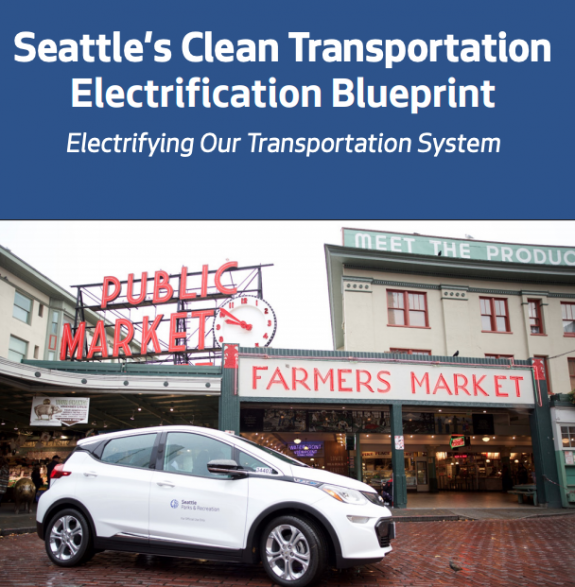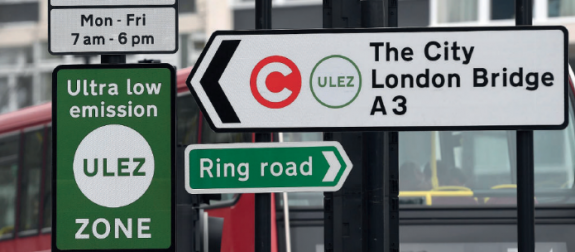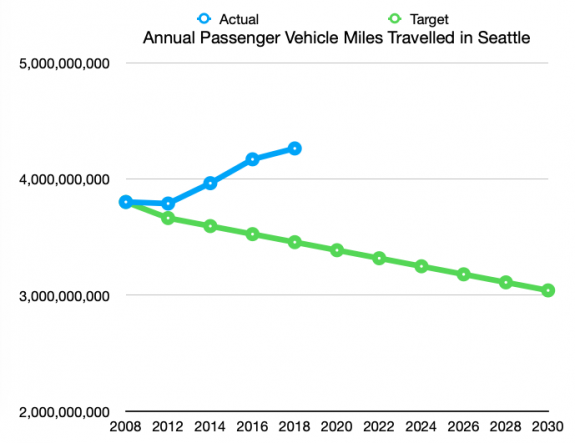City transportation electrification “blueprint” includes emissions-free area by 2030
Today the City of Seattle has released what it's calling a blueprint" to electrify the city's transportation system, further clarifying the city's goals around decarbonizing our largest single source of emissions. Among the goals outlined with a 2030 deadline is for the city to create a major area where walking, biking, and transit are the primary modes and goods are delivered by electric or other non-emitting vehicles, and other personal vehicles are restricted.

That goal actually comes directly from a commitment the City made in 2017, when then-Mayor Tim Burgess signed onto a declaration along with eleven other cities from around the world to ensure that a major zone in their city is zero emission by 2030. At the time, Mayor Burgess was quoted alongside Paris Mayor Anne Hidalgo as saying, Responding to climate change's threat requires big thinking and bold action". Paris has proceeded with a fundamental reshaping of the city's streets, with around 30 miles of pop-up bike lanes added in just 2020 that will likely all remain permanent. Seattle built around 2 miles of protected bike lanes last year.
London, another signatory on the 2018 commitment, has already implemented an Ultra Low Emission Zone (ULEZ) of around 8 miles in the center of the city, and another Low Emission Zone (LEZ) that covers the rest of the city. Vehicles not meeting certain emission standards are charged to enter the zone; this is separate from the congestion charge also in place in London. Emissions policies like this have had already contributed to a reduction of 44% in roadside NO2 levels in Central London between February 2017 and January 2020 and an an expected 13% reduction in carbon dioxide emissions, according to the Transport Decarbonisation Alliance, C40 cities, and POLIS. These are the public health benefits that come from emissions reduction zones.

Signage in London indicating the ultra low-emission zone. (C40 cities)
In the US, Santa Monica, California is probably the closest example. A pilot project running through this year implemented a voluntary 1-mile emissions-free delivery zone where curb space is reserved for electric delivery vehicles. Personal vehicles used by residents inside the zone are not covered by the voluntary policy.
Mayor Durkan has not referenced the 2017 commitment for an emissions-free zone in the city much if at all during her tenure. A 2018 announcement to study congestion pricing as part of a vision for a more vibrant downtown with fewer cars, more transit, and less pollution" has not produced anything substantive to date. The update to the 2013 Climate Action Plan released in 2018, included very few concrete strategies to reduce Vehicle Miles Travelled (VMT) and shift vehicle trips away from single-occupancy vehicle to transit and active transportation. Seattle's official 2013 goal for VMT is a 20% drop from 2008 levels by 2030, a modest reduction that the city is currently further away from than when we adopted the goal.

Seattle's vehicle miles travelled trends compared to the goal.
A neighborhood or segment of a neighborhood where most of the cars and trucks permitted to use the streets are delivering goods could amount to one of the biggest shifts of street space to biking and walking ever. Of course, if everyone in Seattle isn't able to access that emissions-free zone or zones, the impact would be limited and likely inequitable.
The plan spends some time addressing that inequality in the transportation system that our choices continue to reinforce. Climate justice is a central focus of this plan," it states. Our residents and neighbors who are least responsible for climate change and least equipped to adapt, are already disproportionately bearing the health and financial impacts of climate change." Given that it notes that residents living in the Duwamish Valley community in South Seattle will die eight years sooner than other Seattle neighborhoods due to air pollution and exposure to environmental toxins", then that fact should be centered in the urgent task of removing those pollutants, and the emissions that come along with them, from our transportation system.
Among the other 2030 goals in the blueprint is that every single vehicle providing shared mobility", including taxis, Uber, Lyft, as well as electric scooter and bike share, is zero-emissions, that 90% of personal trips are in vehicles that are zero-emission, and 30% of goods delivery is completed by zero-emissions vehicles. Having a city-owned fleet that is also 100% zero-emission by 2030 is also a goal. The blueprint states that these ambitious, yet achievable, goals will accelerate market transformation and make it possible for Seattle to achieve a clean energy future".
Another plan on the shelf with another set of ambitious goals doesn't mean much when we aren't achieving the goals we've already set. If we are actually serious about achieving the goals, it's going to require more specifics and more concrete actions.